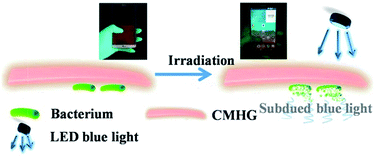“Less Blue, More Clean”: Cu2O nano-cubic functionalized hydrogel for the energy transformation of light-emitting screens†
Abstract
Cubic Cu2O nanoparticle modified hydrogel (CMHG) was synthesized to address two major problems (harmful irradiation and high density pathogens) of the current light-emitting screens simultaneously. The as-prepared hydrogel could conveniently form an adjustable semitransparent film over various shaped screens to provide enhanced antibacterial activity and longer Cu2O service life. More importantly, with the aid of cubic Cu2O nanoparticles, the energy of the harmful blue light irradiation could be effectively transformed into a photocatalysed power source to sterilize the surface of the screen. This low toxic CMHG showed no significant influence on the touch control experience, and had obvious eye protective effects, which thus offered a convenient manner to protect vision and sterilize touch screens at the same time.



 Please wait while we load your content...
Please wait while we load your content...